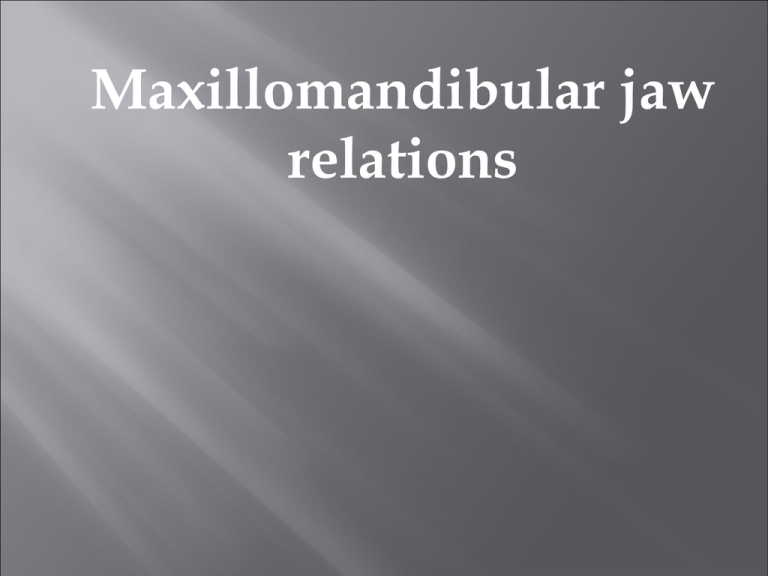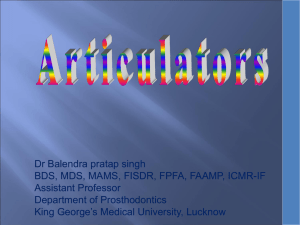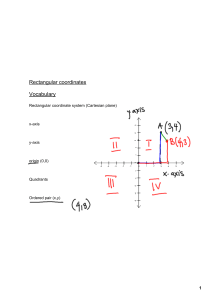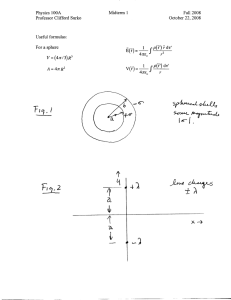Maxillomandibular jaw relations
advertisement

Maxillomandibular jaw relations Definition : A record base or base plate is a temporary form representing the base of a denture. It is used in recording maxillomandibular relations and in the arrangement of the teeth. Requirements : should be rigid. should be accurate. should be stable. the borders should be round & smooth as the borders of finished dentures. should be thin at the crest ,labial & buccal slopes to provide space for tooth arrangement. Definition : occlusion rims are occluding surfaces constructed on record bases or permanent denture bases to be used in recording jaw relations and for arranging teeth. Requirements : the position should be in the anticipated position of the artificial teeth. it must be securely attached to the base. the occlusal surface must be smooth and flat. it should be contoured to support the lip and cheeks accurately. all the surfaces should be smooth. Uses : The occlusion rims are used : to establish the level of the occlusal plane. to establish the arch form. to record the maxillary mandibular relations. for arrangement of the teeth. Wax rims are smooth and have a flat occlusal surface. They are about as wide buccolingually as denture teeth – wider in the posterior, narrower in the anterior The occlusal rim must be centered buccallingually over and parallel to the residual ridge crest. The anterior portion of the maxillary occlusal rim is labially oriented The anterior wax rim height is 22-mm on the maxillary and 18-mm on the mandibular arch. The width of the anterior rim is approximately 3to 4-mm thick. The width of the occlusal rim in the posterior region is approximately 8- to 10-mm thick. The occlusal rim is properly sealed to the baseplate without any voids. The posteriors of the occlusion rims are cut at a 30º angle to the occlusal plane The occlusal plane is defined as the average plane established by the incisal and occlusal surfaces of the teeth". Importance of orientation of occlusal plane Anteriorly, occlusal plane mainly helps in achieving esthetic & phonetic. posteriorly, it forms a milling surface, where tongue & buccinator muscle are able to position the food bolus onto it , and hold it there during mastication. Incorrect of occlusal plane would hamper esthetics, phonetics, & mastication. It may affect stability of complete denture & ultimately result in alveolar bone resorption. Maxillomandibular relations is defined as any spatial relationship of the maxillae to the mandible ; any one of the infinite relations of the mandible to the maxilla (GPT 7). An accurate determination,recording and transfer of jaw relation record from edentulous patient to the articulator is essential for restoration of function,facial apperance and maintaince of patient health. CLASSIFICATION: Boucher classified jaw relations into three groups, • 1. Orientation relations • 2. Vertical relations • 3. Horizontal relations ORIENTATION RELATION Orient the mandible to the cranium in such a way that when the mandible is kept in its most posterior position, the mandible can rotate in a sagittal plane around an imaginary transverse axis passing through or near the condyles. THE GLOSSARY OF PROSTHODONTIC TERMS , 7th EDITION , THE ACADEMY OF PROSTHODONTICS,1999. THE AXIS CAN BE LOCATED BY THE FACEBOW. ORIENTATION OF MAXILLA IN RELATION TO BASE OF SKULL Plane of maxilla may be tilted in some patients , in such cases plane of mandible will not be altered since it articulates with base of the skull. Hence , a maxillary tilt will alter the relationship of maxilla to mandible during different movements, also affect the level of occlusal plane . A face bow is a caliper- like instrument used to record the spatial relationship of the maxillary arch to some anatomic reference point or points and then transfer this relationship to an articulator ;it orients the dental cast in the same relationship to the opening axis of the articulator. (GPT 7) Customarily The Anatomic References Are The Mandibular Condyles Transverse Horizontal Axis & Other Selected Anterior Reference Point. Also Called Hinge Bow . ARMAMENTARIUM DIAGRAMMATIC PRESENTATION OF A FACE BOW CONDYLE EAR BOW : AN INSTRUMENT SIMILAR TO A FACE BOW THAT INDEXES TO EXTERNAL AUDITORY MEATUS [EAM] & REGISTERS THE RELATION OF MAXILLARY ARCH TO EAM & HORIZONTAL REFERENCE PLANE.PROVIDES AN AVERAGE ANATOMIC DIMENSION BETWEEN EAM & HORIZONTAL AXIS OF MANDIBLE. THE GLOSSARY OF PROSTHODONTIC TERMS , 7th EDITION , THE ACADEMY OF PROSTHODONTICS,1999 The face bow helps to relate the jaws to the arc of closure or hinge axis of the mandible. When this relation is transferred to the articulator ,it simulates some of the jaw movements of the patient. Establishes the relationship between the maxillary arch and the horizontal plane. Transfers this relationship to the articulator. Provides for an accurate mounting of the maxillary cast to the articulator. The missing teeth are restored by the CD,FPD,RPD to restore function & esthetics . It is essential to develop proper occlusion for maintaining health of supporting structures orofacial musculature,TMJ. So there is a need for accurately locating the hinge axis & recording & transferring the same on to the articulator, to enable the accurate reproduction of occlusal relationship on an articulator. This is achieved by Face bow which records the position of jaws in relation to the condylar mechanism & aids in transferring the same relation onto the articulator. Lazzari has listed the advantage for using the face bow1. It permits the more accurate use of lateral points for the arrangement of the teeth . 2. It aids in securing the antero-posterior cast positioning with relation to the condyles of the mandible . 3. It registers the horizontal relationships of the cast quite accurately and thus assist in correctly locating the incisal plane. 4. It is an aid in the vertical positioning of the cast on the articulator. Failure to use the facebow can lead to errors in occlusion of the denture. Occlusal error on full occlusal rims The errors would be negligible if all the interocclusal records were made precisely at the occlusal vertical relation at which the occlusion was to be established and if zero-degree teeth were used. If cusp teeth are used or if interocclusal records are made with the teeth out of contact so that the vertical separation of the casts or dentures must be reduced on the articulator, the face-bow record is essential. The Face bow transfer allows a more accurate arc of closure on the articulator when the interocclusal records are removed and the articulator is closed. Its use requires little time, and the convenience it provides in the cast-mounting procedure saves that time. SO………Indications for the Use of Face-Bow I. II. When balanced occlusion is desired in centric as well as eccentric positions. When cusp form teeth are used. (Definite cusp fossa/cusp tip to cusp incline relation is desired ) III. When interocclusal check records are used for verification of jaw position IV. For constructing accurate crowns and bridges. V. In full mouth rehabilitation, when accurate occlusal restorations are to be made. VI. When occlusal vertical dimension is to be changed during teeth setting. VII. For diagnostic mounting and treatment planning. VIII. In gnathological studies and treatment. IX. For making occlusal corrections after denture processing. HINGE AXIS Also called as - Terminal Hinge Axis Transverse Hinge Axis Transverse Horizontal Axis According to GPT 7 ; HINGE AXIS is an imaginary line around which the mandible may rotate within the sagittal plane. Terminal Hinge axis is a horizontal axis around which the condyles rotate during opening and closing movement upto a range of 20-25 mm. Beyond this range there is translation. TODAY WITH CHANGING CONCEPT OF CENTRIC RELATION,VIZ. ANTEROSUPERIOR BRACING ,THE TERM TRANSVERSE HORIZONTAL AXIS IS PREFERRED TO TERMINAL HINGE AXIS. THE DISCREPANCY OF HINGE AXIS BETWEEN RUM POSITION & ANTEROSUPERIOR POSITION IS 0.2 mm [HOBO] True condylar rotation. 12º rotation with maximum incisal separation of 22mm. WHY TO RECORD AND TRANSFER HINGE AXIS? OPENING & CLOSING MOVEMENTS OF MANDIBLE ARE REPRODUCED ACCURATELY AS THE OPENING AXIS OF THE ARTICULATOR IS COINCEDENT WITH HINGE AXIS OF PATIENT. THEREFORE, TEETH CONTACT EACH OTHER ON THE ARTICULATOR IN THE SAME WAY AS THEY DO IN PATIENT’S MOUTH. IT IS THE STARTING POINT OF LATERAL MOVEMENTS. PERMITS VERTICAL DIMENSIONS TO BE CHANGED ON THE ARTICULATOR. HELPFUL IN DIAGNOSIS & TREATMENT PLANNING OF MOUNTED STUDY CASTS. Distance between External Auditory Meatus and Hinge axis AMONG THE THREE COMMONLY RECOMMENDED TRAGAL REFERENCES FOR ALA TRAGUS LINE , PARALLELISM TO OCCLUSAL PLANE WAS USUALLY SEEN WHEN MIDDLE OF THE TRAGUS WAS TAKEN TO FORM ALA TRAGUS PLANE . AMONG THE SEVEN TRAGAL REFERENCES SELECTED TO ORIENT THE ALA-TRAGUS PLANE TO OCCLUSAL PLANE,PARALLELISM WAS SEEN WHEN TRAGAL REFERENCE WAS BETWEEN SUPERIOR BORDER & MIDDLE OF THE TRAGUS [41.5%]. INFERIOR BORDER SERVED AS A POOR REFERENCE[2.3%] 1.TRAGAL REFERENCES TO ESTABLISH TRAGUS – CANTHUS LINE TO LOCATE ARBITRARY HINGE AXIS AUTHOR TRAGALREFERENCE WINKLER TOP OF TRAGUS SWENSON TOP OF TRAGUS HEARTWELL & RAHN MIDDLE OG TRAGUS McGREGOR APEX OF TRAGUS SHALLHORN & BECK POSTERIOR MARGIN OFTRAGUS BEYRON CENRE OFTRAGUS Reference points The maxillary cast in the articulator is the base line from which all occlusal relationships starts, and it should be positioned in space by three points. The plane is formed by two points located posterior to the maxillae and one point located anterior to them. The Anterior point of reference The selection of the ant. point of the triangular spatial plane determines which plane in the head will become the plane of reference when the prosthesis is being fabricated. In selecting the reference plane, the dentist should have knowledge of following anterior points--- 1) ORBITALEin skull, orbitale is the lowest most point of the infraorbital rim. One orbitale &the two posterior points that determine the horizontal axis of rotation will define axisorbital plane. Orbitale & the two posterior landmarks define the plane are transferred from the patient to the articulator with the face-bow. The articulator must have an orbital indicator guide that is in the same plane as the hinge axis of the articulator. The axis-orbital plane can be transferred to the articulator in another way, the face-bow itself is raised to the axis-orbital plane on the patient. 2) ORBITALE MINUS 7MM. Because porion is a skull landmark, we uses the midpoint of the upper border of the ext. auditory meatus as the posterior cranial landmark on the patient & this post. Tissue landmark on the average lies 7 mm superior to the horizontal axis. To compensate this , mark the ant. Reference point 7 mm below orbitale on the patient. 3) NASION MINUS 23 MM Nasion is the deepest part of the midline depression just below the level of eyebrows. The nasion guide of the Quick Mount face-bow used in Whip-Mix articulator fits into this depression. this guide can be moved in and out but not up and down, from its attachment to the face-bow crossbar. The crossbar is located 23 mm below the midpoint of the nasion positioner. Face-bow crossbar and not the nasion guide is the actual ant. reference point locator . 4) ALAE OF THE NOSE The wax occlusion rim made parallel with Camper;s line is transferred to the articulator with a face-bow. Its occlusal plane is made parellel with the upper and lower articulator arms. In this way ,the ala-axis plane and the tentative occlusal plane are horizontal and become the planes of reference. Posterior point of reference STANDARD PROCEDURES FOLLOWED TO LOCATE ARBITRARY HINGE AXIS: 11-5 ARBITRARY HINGE AXIS LOCATION: SRIBBING A HORIZONTAL FROM SUPERIOR NOTCH OF TRAGUS OF EAR TO OUTER CANTHUS OF EYE.POINT MARKED 11mm ANTERIOR ON THE TRAGUS FROM WHICH A POINT 5mm DOWN IS MARKED AT RIGHT ANGLE TO TRAGUS CANTHUS LINE TO LOCATE ARBITRARY HINGE AXIS. BEYRON’S POINT: 13mm ANTERIOR TO THE POSTERIOR MARGIN OF TRAGUS ON A LINE FROM CENTER OF TRAGUS TO OUTER CANTHUS OF EYE. Beyron’s point LUNDEEN’S POINT: 13mm ANTERIOR TO TRAGUS ON LINE FROM BASE OF TRAGUS TO OUTER CANTHUS OF EYE SIMPSON’S POINT: 11 mm ANTERIOR TO SUPERIOR BORDER OF TRAGUS ON CAMPER’S LINE. WEINBERG’S POINT: 11-13 mm ANTERIOR ON A LINE DRAWN FROM MIDDLE & POSTERIOR BOEDER OF TRAGUS. ABDAL-HADI POINT-It is based on the high co relation between the width profile of the face &X co-ordinate of kinematic point. Y = 9.5+0.95(X) A constant distance equal to 0.5 m was used above the line passing from center of the external auditory meatus to canthus to locate the supero inferior position. GYSI’S POINT: Gysi placed it 11-13 mm anterior to the upper third of the tragus of the ear on a line extending from the upper margin of the external auditory meatus to the outer canthus of the eye. Gysi point BERGSTROM’S POINT: 11mm ANTERIOR TO THE POSTERIOR MARGIN OF TRAGUS ON A LINE PARALLEL TO & 7mm BELOW FRANKFORT HORIZONTAL PLANE. BERGSTROM’S POINT Arbitrary Hinge Axis Accuracy % Investigator 98.0 Schallhorn, Beyron, Points BEYRON’S POINT Beck GYSI’S POINT 40.0 Beck, Lauritzen and Bodner LUNDEEN’S POINT 33.0 Teteruck and Lundeen BERGSTROM’S POINT 83.3 Beck Ear axis 75.5 Teteruck and Lundeen A-Frankfurt Mandibular Plane Angle Frankfurt horizontal plane Mandibular plane Camper’s or Bromell plane Prosthetic plane OR P 12° A ANS GO ME TYPES OF FACE BOW ARBITRARY FACE BOW KINEMATIC FACE BOW facia type ear piece type hanau face bow[sring bow] slidematic[denar] twirl bow whip mix FACIA TYPE HANAU FACE BOW ATTACHED TO HANAU ARTICULATOR EAR BOW RECORD CHOICE OF FACE BOW FOR RECORDING TRANSVERSE HINGE AXIS DENTAL PROCEDURES SUCH AS EXTENSIVE RESTORATIVE PROCEDURES ,DIAGNOSIS OF OCCLUSION IN TMJ DISORDERS ,DIAGNOSTIC WAX UP,SELECTIVE GRINDING,ect.,WHERE PRECISION IS INDISPENSIBLE,TRANSVERSE HINGE AXIS LOCATION & TRANSFER IS BENEFICIAL. ARBITRARY FACE BOWS SUCH AS EAR PIECE FACE BOW & FACIA FACE BOW HAVE THEIR OWN ACCURACY LIMITATIONS. HOWEVER , A CORRECT ARBITRARY FACE BOW TRANSFER IS BETTER THAN AN INACCURATE TIME CONSUMING HINGE AXIS RECORD. “IN THE ABSENCE OF TRUE HINGE AXIS MOUNTING , ARBITRARY FACE BOW SERVES THE PURPOSE,BUT TO A LESSER ACCURACY.” ARBITRARY FACEBOWS: a. Make use of arbitrary or approximate points on the face as the posterior reference points. b. The condyle rods are positioned on these points. c. Sufficient for the fabrication of complete dentures, fixed partial and removable partial dentures. d. Small error in location while using an arbitrary facebow will have only a negligible effect at the occlusal level. e. The resiliency and life effect of the oral tissues make the exact transfer and location of the hinge axis unnecessary. FASCIA TYPE : The earpiece face bow is converted to a fascia bow simply by removing the earplugs. Utilize posterior reference points on the skin over the temporomandibular region. Makes use of condylar rods instead of ear inserts. A. HANAU FASCIA BOW B. CLOSEUP OF THE CONDYLAR ROD EARPIECE TYPE : First described by DALBEY in 1914. Gained popularity during the 1960’s. Use the external auditory meatus (which has a fixed relationship to the hinge axis) as the arbitrary posterior point. Each earpiece has a central hole that connects to the auditory pin on the articulator. A rounded nylon earpiece is attached to the medial end of each scale. HANAU EARPIECE TYPE 1. EAR INSERT CLOSEUP 2. COMPENSATOR In articulators which do not have auditory pin, a condylar compensator is needed. Special condylar compensators on the facebow or articulator compensate for this by positioning the condylar inserts at a certain distance behind the hinge axis of the articulator. The earbow is simple to use. Does not require measurements or marks on the face. The accuracy is similar to other arbitrary methods. The auditory pins are related to the articulators horizontal axis in the same way the patients external auditory canals relate to the patients horizontal axis. KINEMATIC FACEBOW 1. It is used to locate and transfer true hinge axis. 2. Complex instrument requiring the fabrication of clutches which are attached to the lower jaws. 3. It requires more chair time . 4. It also requires the use of articulators with extendible condylar shafts (e.g. Hanau H2X) which must be extended to meet the stylus of the facebow. The kinematic face bow will locate the opening axis physiologically with exceptional accuracy while the arbitrary face bow is based on average computations of an axis of the jaw by using anatomical landmarks. The kinematic face bow locates the rotational points by attaching to the mandible . As the patient opens and close his mouth, a pointer is adjusted until the axis of location is adjusted. PARTS OF A FACEBOW U-Shaped frame Condyle rods Bite Fork Locking Device Orbital Pointer Condyle rods Orbital pointer U-shaped frame Locking clamp Bite fork U-Shaped frame Two small metallic rods on either side of the free end of the U-shaped frame that contact the skin over the TMJ. They help to locate the hinge axis or the opening axis of TMJ and transfer the hinge axis by attaching to the condylar shaft in the articulator. U-shaped frame The face-bows that have a condylar rod to record true hinge axis are called Kinematic face-bows. Some face-bows do not have condyle rods instead they have an earpiece which fits into the external auditory meatus. These face-bows do not record the true hinge axis and hence are called Arbitrary face-bow. Condyle rods Bite Fork It is a U-shaped plate which is attached to the occlusal rim while recording the orientation relation and it represents the plane of maxilla. Position the bitefork so that the midline mark of the fork lines up with the patient’s midline recorded on the rim Orbital Pointer It marks the anterior reference point (infraorbital notch) and is present only in arbitrary face-bow. ORBITAL POINTER THE EARPIECE FACE BOW USES EXTERNAL AUDITORY MEATUS AS POSTERIOR REFERNCE POINT RELATIONSHIP OF EXTERNAL AUDITORY CANALS TO HORIZONTAL AXIS IS SUPPOSED TO BE CONSTANT EAR PIECES ARE PLACED IN THE EXTERNAL AUDITORY CANALS OF PATIENT. WHILE TRANSFERRING THE RECORD THE EAR PIECES ARE SEATED ON THE AUDITORY PINS OF CENTRIC LOCKS. AUDITORY PINS ARE RELATED TO ARTICULATOR’S HORIZONTAL AXIS IN THE SAME WAY AS PATIENT’S AUDITORY CANALS RELATE TO PATIENT’S HORIZONTAL AXIS. PROCEDURE FOR FACEBOW TRANSFER The bite fork is attached to the upper occlusal rim. A variety of techniques are available to attach it. In one technique, the bite form is heated and inserted into the labial and buccal surfaces above the occlusal plane. BITE FORK IS ATTACHED TO THE OCCLUSAL RIM WITH ALUWAX In another technique, the bite fork is attached to the occlusal surface with wax or impression compound. PREPARING THE OCCLUSAL RIM TO RECEIVE THE BITE FORK The recording base is inserted into mouth, and extension rod of the bite fork is passed through the locking device of the face bow. The posterior reference point is measured and marked-13 mm anterior to the tragus on the tragus-canthus line . When using the earbow this procedure is not necessary. The condylar rod is positioned on this mark (when using the earbow. The ear insert is positioned in the external auditory meatus). Condylar rods are moved from side to side until the readings are the same on both sides. Locknuts at the condylar rods are the tightened to suspend the face bow and bite fork is secured to the assembly. The instrument should be locked in the centric with the incisal pin flush with the upper member. The clamp holding the bite fork is also lockedgently first and then firmly The orbitale pointer when present is positioned so that its tip points to the orbitale . All the locking nuts and clamps are secured. The whole assembly is then disengaged from the patients face. This is done by loosening the condylar rods. The facebow assembly including the bite fork with attached facebow is slipped off the patients face. The whole assembly (including occlusal rim) is then positioned in the articulator. The condylar rods are locked on the hinge axis extensions of the condylar analogs on the articulator,in the earpiece type. The condylar rod is positioned behind the articulator hinge axis to compensate for the posterior position of the auditory meatus. A condylar compensator may be used in articulators which do not have the auditory pin. The position of the occlusal plane in the articulator is decided and the facebow is raised or lowered accordingly ( using the elevating screw of the facebow). Many use the midplane of the articulator as marked on the incisal pin, whereas others adjust it according to the Frankfort plane ( the orbitale pointer of the facebow is related to the orbitale indicator on the upper member of the articulator. The upper cast is attached to upper record base. The weight of the occlusion rim and cast is supported with the help of a cast support (also called mounting prop). The notches(indices) in the base of the cast are lightly lubricated. The upper cast is then secured to the upper arm of the articulator with plaster After the plaster sets, the facebow is disassembled. The articulator is placed upside down. The lower occlusion rim is related to the upper occlusion rim with the help of the centric relation record made earlier. The lower mounting is complete with mounting plaster. The articulator is now ready for customizing i.e. programming of the condylar and incisal guidances. OTHER METHODS OF RECORDING HINGE AXIS • Pantograph– two face bows, one holds six recording tables attached to the mandible & other with 6 styluses attached to the maxillae. • Transograph. • Stereograph • Computerized Axiograph INACCURACY IN FACE BOW RECORDING AND CAST MOUNTING There are several related factors – 1. Failure to locate the arbitrary hinge axis point of the same place at each recording session. 2. Failure of the subjects to place the ear pieces of the face bow in the external auditory meatus in their proper places because the diameters of the EAM are not the same for all individuals or even right to left in same individual. 3. Failure to seat the maxillary teeth properly in the occlusal index. 4. Failure to set the cast properly into the occlusal index when mounting on the articulator. 5. Cast support place in such away that the face bow fork would be displaced. 6. The difference in stone expansion to mount the cast on articulator. 7. Error occurring during measurement procedures.



